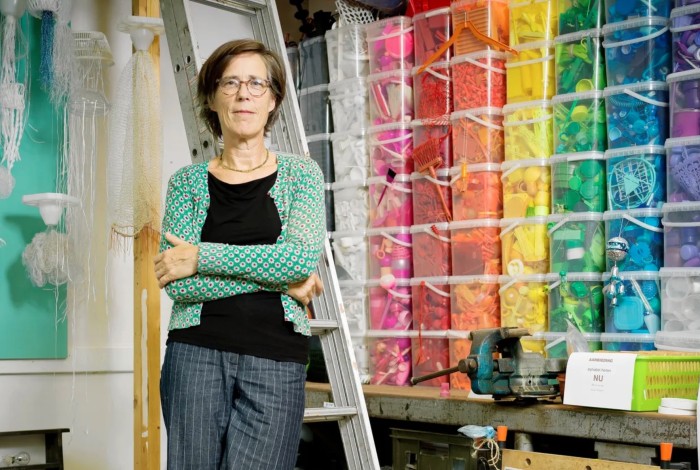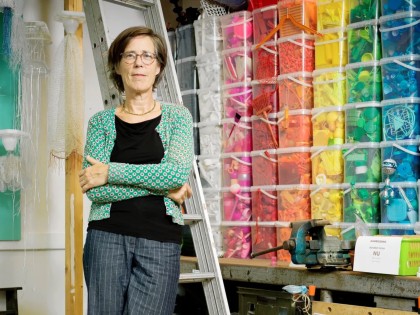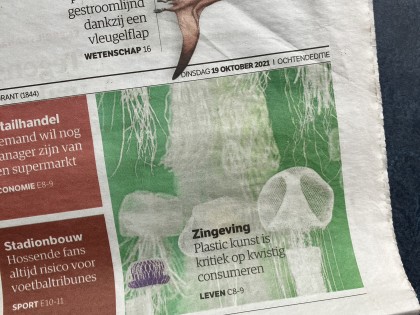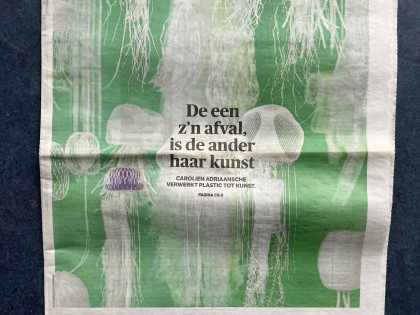NRC
19 October 2021

On Tuesday, Oct. 19, I was featured in the NRC.
Two pages of text by Freek Schravesande and photos by Merlijn Doomernik.
Carolien Adriaansche: 'I just want cheerfulness, life is already so...'
What makes life worth living? Carolien Adriaansche (58) makes art out of plastic. Adriaansche works with what she gets and what she finds, on the street, on the beach, in markets. She benefits from the consumer society she opposes. "I am a kind of waste disposal company," she says.
Nothing beats Italian design. Carolien Adriaansche grabs the detergent bottle from the cabinet and moves her finger along the vertical ribbed pattern that accentuates its subtle curves. The empty vial, in monochromatic lilac, is stripped of its label. "Now look how beautiful. The classic shape, the chic, that color."
She reaches for another vial, from France. "There's a gradient in this one." And after some searching in her collection, she also finds the very first gold bottle on the Dutch market. "Glorix."
There were times when Carolien Adriaansche invariably visited the cleaning department in the supermarket. Preferably in one of those hypermarkets, on vacation with her family, the shelves filled with vials in new shapes, new colors. She sometimes took as many as eight. At home, she regularly heard her roommates sniffing - "what is this smell? - and often she poured over the vials. At dinner parties with friends, she would bring a bottle of detergent in addition to a bottle of wine.
It's been a while, because Carolien Adriaansche (58) is dying of plastic. She turns it into floating cities, exhibited in the ponds of big cities. And her beasts with Latin names, a new biodiversity, traveled the world, from Paris to Hong Kong, Lisbon and New York. In schools, as "Afvaljuf," she helps children create something from their own plastic waste.
Walk into her studio in The Hague and you'll find piles of vials, crates, laundry baskets, pen caps, medicine caps, bubble blisters, whipped cream syringes, deodorants, toilet fresheners. All plastic in its naked form, without print or label, washed and sorted by color. Detergent bottles hang like clouds from the ceiling and like hunting trophies on the wall. Smaller plastic parts can be found stacked in plastic boxes that once contained peanuts - collected by a friend in the restaurant business. Seven boxes of white plastic, seven yellow, seven orange, seven red, seven pink, et cetera. Also in the studio are bags full of nets that previously held Christmas trees - she makes jellyfish out of them - and on her workbench is a box of dozens of used corona tests (one positive) that she does not yet know what she will do with. "A fun new waste stream."
Carolien Adriaansche has built a network of suppliers after more than 20 years of collecting plastic. Friends, family, neighbors, colleagues, a household with soccer-playing children that consumes one bottle of detergent a week. And she also has regular dealers at the Hague market. As she walks past stalls of fruit and vegetables, peering at what lies behind them, there are always market people who keep some crates aside for her. Some crates have deposits, most do not.
"I was just there this morning," Adriaansche says hurriedly searching for a packet of cookies for tea. "Yes, sorry, I have a very full day. For a project with college students I need crates, because we're going to build one of those floating cities, and I had actually wanted to collect them last week but then I really didn't have time, and I do have some lying around, but not that much, and it's also always exciting what's on the market, because sometimes I like black and sometimes I like white, and right now there was a lot of black, of good quality, and there was often ginger or avocado in there, and otherwise that just gets thrown away. So now I have a whole load of crates in the car, and I just thought to myself: did I turn on the parking app?"
She has to laugh. "Actually, I'm a very unstructured, chaotic person, haha. I thought beforehand: are you sure you want to interview me?"
But looking at those boxes, I think: perfect color!
"Yes, there has to be some structure somewhere. That's my handhold, I do need that."
So how does that work in your head, that chaos?
"Oh well, of course it has its positive sides. Through chaos, things arise naturally. People ask: how do you think of it? Well, things just happen in my head or something. Like with those hunting trophies. Then I lie awake at night and suddenly something pops up. Like a light almost."
What do you lie awake over then?
"Of all the struggles in life." She smiles. "I have a very happy life you know. I'm a hugely privileged person. That I have such a workplace, such a beautiful studio. No material costs! What artist can say that? But in ordinary life, that chaos can also be a hindrance. Then at night my imagination runs wild. I think: ooh, it's storming too hard. Ooh, my house is four-and-a-half feet below sea level. I'm pretty gloomy minded."
Somber minded? But.
"Yes, my work is very cheerful, isn't it? That's nice, that gives light to existence. But in the meantime I think: how should it continue? I have two children, but haven't wanted children for a long time. And sometimes I tell myself: what nonsense, there are always solutions to save the climate. But actually I am pessimistic about that."
Where does this anxiety come from?
"I had it as an adolescent. I had a happy childhood, never setbacks or anything. But in my head I was often preoccupied with war, Hiroshima, the glass was always half-empty. I read those very heavy books, like Ward Ruyslinck's, about the wickedness of man. Whew, I mustn't think about that now! I just want cheerfulness now, life is already so..."
Sometimes you just have to start, muddle through
Carolien Adriaansche apologizes because her studio is quite tidy. "Not normally, mind you." Yesterday was open day, hence. Then a little boy pointed to the plastic miniature city on the cupboard, built from caps and bell-bottoms, and said, "there should be a dot under there, then it would be like a Star Wars spaceship.
She picks it up and points to an upside-down whipped cream syringe, used as a turret. "Look at this. This top one is smooth, and then here's one of those little ridges. That's very well thought out. And here, this is the toner from a printer. And this, from one of those Tipp-ex rolls you know."
Adriaansche doesn't bend the plastic, she doesn't cut it up, she doesn't paint it. Plastic is beautiful enough by itself. All she does with it is sort it by color and glue it together so that all the individual parts come together to form a new whole.
Some people want to pay attention to the environment and therefore make art, with Carolien Adriaansche it was the other way around. She thought plastic was just really beautiful. The simplicity, the form. She started collecting junk at an early age. Cigar bands, cardboard, sticks, plastic. In the early 1990s, after a visit to the Natural History Museum in Rotterdam, her collection coincided with a love of determinism and her first collections were born: animals in boxes.
Her attention to the environment grew, as did the plastic trash on the streets. Over the years, she saw the offerings become more colorful - brands want to stand out on the shelf - and the openings of shampoo bottles also became larger - then they run out sooner.
Adriaansche works with what she gets or finds on the street or on the beach and "really likes to dive into containers." That's also the most fun, she thinks, being surprised by the material. That's why all that stuff surrounds her, so that coincidence can also arise. And then she just starts. Sometimes it works, sometimes it doesn't. "She calls it "muddling along.
You let yourself be led by chance.
"Yes yes yes yes. And the nice thing is that as Waste Miss at schools I also come up with new ideas. I let the kids bring their own plastic from home to make them aware. Sometimes they bring materials I didn't know about."
Can children do something with that, such a piece of plastic?
"Well, not all of them. I start low-key and some make the most beautiful things. But I regularly shock how children react. They are not used to this freedom. They want to fake something. But then when they have to think of something themselves..."
Then a short circuit occurs?
"Then there are eyes on the detergent pack, but they don't get any further."
What's the reason for that?
"I think it's sad, all those kids so young with those tablets. Go play outside, get dirty, fiddle around. There could be more attention in schools for discovery learning. But education is not set up for it. Then I give them some tips and tricks and say: boys, go make animals out of garbage! And if they make a car or a rocket, that's fine too. But those teachers sometimes think that's wrong. They say: that wasn't the assignment. While I think: gosh, they already have to do so many assignments. That's such a shame, that education is so stuck. Everything has to be measurable, testable."
Pretty efficient though, right?
"Yes, that's why. And I get it, too. Classes with thirty children, parents with two jobs. Then, of course, there is no attention for anything different. You opt for uniformity. Everything has to be compact, with a purpose. That's the easiest. Just like in the packaging industry."
Children are like bottles of Glorix.
"Once I was standing in line at the supermarket when I overheard a father talking about his daughter's choice of study. He said, 'that's so important, because she's stuck with that for the rest of her life.' I interfered because I thought, ho, what nonsense is that!"
You wish there was more dabbling?
"I never thought about becoming an artist. Rather heart surgeon or something. I did the village secondary school, then the havo and then an agricultural and garden architecture course, following my father. I briefly thought about becoming a carpenter but I didn't like the training, so then it became "interior design" at the art academy and then, after a nice exchange in England, theater design at the Rietveld. After that I enjoyed working in theater for ten years. I am a diesel, very slow, a huge late bloomer. It wasn't until I started plastic twenty years ago that everything fell into place."
Then you knew: now it's going somewhere.
"Well you don't even know that. But then it just happens and when you look back and put everything together, it seems logical."
It's important to spark discussion
Adriaansche points to a yellowed 2009 NRC, hung above her desk. 'Tinkering with the Earth' is the headline. The article is about global warming and what we can do about it. But the article is a misprint. The pictures are double-printed, like looking at them drunk.
What does that say?
"I do find that fascinating, that misprint. Almost something symbolic. Like it's so simple, the solutions."
Do you blame consumers for anything?
"I don't like pointing fingers. I myself am not holy either. For my exhibition in Lisbon, I wanted to go by train, but then you're in for 36 hours."
You got on a plane.
"And that chafes enormously. Because then, as an artist, I draw attention to the climate and then... Look, I hardly buy new clothes or stuff, I wash myself with a bar of soap. But um..."
Man is consuming himself all over the place....
"Yes, but that's also double. I benefit from that, as an artist. I'm a kind of garbage collector. I live off that consumer society. And I also understand when you're at the bottom of the ladder. Then it's nice that you can still buy something cheap, something made of plastic. But I do blame companies. They should take responsibility. And when I think of all the money Amazon makes with all that stuff, and then a guy like that wants to fly in a rocket..."
What does such a rocket say about man?
"Well, then I am reminded again of the books I read in my adolescence, about the wickedness of man. And that we, as humans, justify everything. Like when I fly to Lisbon and people say: oh well, you never flew much anyway."
There is always a fabric softener to be found.
"Indeed. And I'm a gloomy person, so I push those kinds of thoughts away. And then it helps to make things like this. Not that I'm helping the climate by doing that. But I think it's important to start the discussion in a positive way. It's already nice if people become a little aware."







